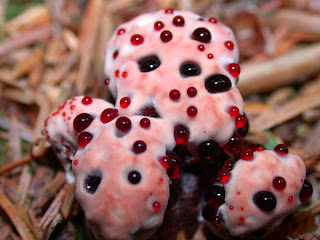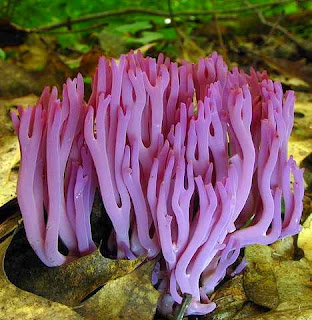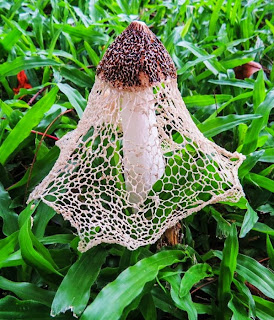Amethyst Deceiver (紫晶騙子)
Laccaria amethystina is commonly known as the Amethyst Deceiver. This purple beauty is found in deciduous and coniferous forests in temperate zones around North America, Central and South America, Europe, and Asia.
Though vividly purple when young, older specimens loose their bright coloration and are more difficult to identify, which is why it is called the "deceiver". Though technically edible, it isn't considered a good choice to eat especially because pollutants in the soil, such as arsenic, can bioaccumulate in the mushroom.
Bleeding Tooth(血齒)
像冰淇淋吧?
The unusual appearance of these mushrooms has earned the species several descriptive common names, including strawberries and cream, the bleeding Hydnellum, the bleeding tooth fungus, the red-juice tooth, and the Devil's tooth.
Hydnellum peckii is an inedible fungus, and a member of the genus Hydnellum of the family Bankeraceae. It produces spores on the surface of tooth-like vertical spines that hang from the underside of the fruit bodies. It is found in North America and Europe and, in the last few years, was also discovered in Iran (2008) and Korea (2010). Though they don't seem to be poisonous, they have an extremely bitter taste and so are inedible.
Coral Fungi (紫珊瑚)
Coral Fungi of the genus Clavaria look very similar to some corals found growing in deep water reefs. There are over 1,200 species of Clavarioid fungi spread across a range of different genera, families and orders.
Coral fungi can exhibit a wide variety of colors from pure white through brilliant orange and rich, organic purple. They are not considered to be edible. Originally such fungi were referred to the genus Clavaria, but it is now known that clavarioid species are not all closely related.
Devil's Cigar (魔鬼雪茄)
像吃剩的冬瓜皮嗎?
This is an extremely rare mushroom, and is found only in very select locations in Texas and Japan and is notable for its unusual appearance and discontinuous distribution.
Chorioactis is a genus of fungus that contains the single species Chorioactis geaster; the mushroom is commonly known as the devil's cigar or the Texas star in the United States, while in Japan it is called kirinomitake. In Texas, the fruiting body grows on the roots of dead cedar elms, while in Japan it grows on dead oak trees. The fruit body somewhat resembles a dark brown or black cigar before it splits open radially into a star-like arrangement of four to seven leathery rays. The fruit body opening can be accompanied by a distinct hissing sound and the release of a smoky cloud of spores.
Dog Stinkhorn (狗莖)
Mutinus caninus, commonly known as the dog stinkhorn, is a small thin, phallus-shaped woodland fungus, with a dark tip. This fungus is found in Europe, Asia, and eastern North America. It is named for it's apparent resemblance to a male dog's member.
It starts as an egg-like fruiting body hidden in leaf litter in soils, and when the egg splits, the mushroom expands to its full height. The tip is covered in a smelly spore-bearing slime that attracts insects, which help to disperse the spores. It is often found growing in small groups on wood debris, or in leaf litter, during summer and autumn.
Entoloma Hochstetteri (碧藍菇)
藍精靈的家嗎?
This Sky Blue mushroom (Entoloma hochstetteri) is a woodland-dwelling fungus found in western parts of New Zealand’s North and South Islands as well as occasionally in India.
It is found in New Zealand and India. Though possibly poisonous, its beauty has been recognized by it being part of a set of fungal stamps issued in New Zealand in 2002 as well as put on the back of a $50 bank note in New Zealand in 1990.
False Morel (羊肚/腦菌)
人類真正用得著的腦袋有多小?
This odd looking mushroom grows a cap that quite resembles the shape of a brain. This mushroom is potentially fatal if eaten raw, but if prepared correctly it is considered a delicacy in Scandinavia, Eastern Europe, and in the Great Lakes region of the US.
Though it can be found being sold fresh in some markets, it is required to come with warning labels. A 1971 study showed that this species accounted for up to 23% of mushroom fatalities each year. It is prohibited from sale to the public in Spain. It may be sold fresh in Finland, but it must be accompanied by warnings and instructions on correct preparation. The toxin in the False Morel affects the liver, central nervous system, and sometimes the kidneys. Symptoms of poisoning involve vomiting and diarrhea, followed by dizziness, lethargy and headache. Severe cases may lead to delirium, coma and death after 5–7 days.
Indigo Milkcap (靛青奶帽)
你敢吃嗎?
This beautiful mushroom can be found in the coniferous and deciduous forests of eastern North America, East Asia, and Central America. Lactarius indigo, commonly known as the indigo milk cap, the indigo or the blue milk mushroom is a species of agaric fungus in the family Russulaceae.
Lactarius Indigo grows on the ground in both deciduous and coniferous forests, where it forms mycorrhizalassociations with a broad range of trees. The fruit body color ranges from dark blue in fresh specimens to pale blue-gray in older ones.
The milk, orlatex, that oozes when the mushroom tissue is cut or broken is also indigo blue, but slowly turns green upon exposure to air. A widely distributed species, it grows naturally in eastern North America, East Asia, and Central America; it has also been found in southern France. It is an edible mushroom, and is sold in rural markets in China, Guatemala, and Mexico.
Latticed Stinkhorn (格子莖)
當耳環還行吧?
Known as the latticed stinkhorn, the basket stinkhorn, or the red cage, this mushroom can be found growing in leaf litter, on garden soil, grassy places, or in mulches.
Though it isn't clear if it is edible, apparently its smell is enough to deter anyone interested in eating it. Tales in southern European folklore suggested that those who handled the mushroom risked contracting various ailments.
Although considered primarily a European species, Clathrus ruber has been introduced to other areas, and now has a wide distribution that includes northern Africa, Asia, Australia, and North and South America.
Lion's Mane Mushroom (獅鬃毛)
太可愛了吧?
Lion's Mane Mushroom, or Hericium erinaceus, is native to North America and can be found growing on hardwood trees. It can go by many other names including Bearded Tooth Mushroom, Hedgehog Mushroom, Bearded Hedgehog Mushroom, Satyr's Beard, Hedgehog Mushroom, Pom Pom Mushroom or Bearded Tooth Fungus.
Lion's Mane is an edible and medicinal mushroom in the tooth fungus group. It can be identified by its tendency to grow all the spines out from one group rather than in branches. Hericium erinaceus can be mistaken for three other species of Hericium which also grow in North America, all of which are popular edibles.
In the wild, these mushrooms are common during late summer and fall on hardwoods, particularly American Beech.
Mycena Chlorophos (夜光菇)
外星人吃嗎?
This glow-in-the-dark mushroom is found in subtropical Asia, including Japan, Polynesia, Java, and Sri Lanka, as well as in Australia, and Brazil. They are bioluminescent, emitting a glowing green light when in the dark.
It is brightest when surrounding temperatures are about 81 °F, and for about a day after the cap forms and opens. After that, the glow dulls until it is undetectable by the naked eye. Mycena chlorophos is a species of agaric fungus in the family Mycenaceae. The mushrooms are bioluminescent and emit a pale green light. They grow in forests on fallen woody debris such as dead twigs, branches, and logs.
Puffballs Mushroom (馬勁)
好像還可有別的用途 (想歪了)
There is more than one variety of puffball mushroom, all of which belong in the division Basidiomycota, and all of which boast unique characteristics. What they all share in common is that they do not grow an open cap with spore-bearing gills, but instead the spores are grown internally and the mushroom develops an aperture or splits open to release the spore.
Calvatia gigantea, commonly known as the Giant puffball, is a puffball mushroom commonly found in meadows, fields, and deciduous forests worldwide usually in late summer and autumn. It is common throughout Europe and North America. Besides their general appearance, they are called puffballs because of the clouds of spores that "puff" out when they burst open or are hit with an impact like falling raindrops. These large white mushrooms are edible when young.
Red Cage Fungus (紅籠)
加個玲給小孩玩的嗎?
Looking like an alien out of a science fiction film, Red Cage Fungus emerges from a whitish “egg” much like the aliens do in popular sci-fi horror flicks…except it doesn't eat people, of course.
If its weird appearance isn't off-putting enough, the aroma surely is. Red Cage Fungus is a relative of the more common, more upright Stinkhorns and it certainly stinks: like a horrific combination of rotting meat and steaming excrement. It goes without saying that it's not edible.
Turkey Tail (火雞尾巴)
還以為有很多火雞捉呢!
This common but incredibly beautiful mushroom is found all over the world. It's fanning shape and layers of coloring resemble a tom turkey's tail. Colors can range depending on location and age, and the cap can be shades of rust-brown, dark brown, grey, and even black.
Trametes versicolor, Meaning 'of several colours', versicolor reliably describes this mushroom found in different colors. Some older caps can appear green when they have a greenish algae growing on them. The turkey tail is considered a medicinal mushroom, and may possibly have positive benefits in protecting against cancer, though this is debated.
Veiled Lady Mushroom (羅莎少女)
這應該不陌生
Phallus indusiatus, commonly called the bamboo fungus, bamboo pith, long net stinkhorn, crinoline stinkhorn or veiled lady, is a fungus in the family Phallaceae, or stinkhorns.
This strange mushroom can be found in gardens and woodlands in southern Asia, Africa, the Americas, and Australia. While the lacy skirt is what draws our eyes, the mushroom actually uses the cap to draw attention too by attracting flies and insects that help disperse the spores. It is edible and is a notable ingredient in Chinese haute cuisine, usually in stir-frys and chicken soups. It is grown commercially and sold in Asian markets, as it is rich in protein, carbohydrates, and dietary fiber; contains various bio-active compounds, and has antioxidant and antimicrobial properties.
.jpg)

.jpg)




















.jpg)





























